
41 minute read
Recent developments in nickel-catalyzed cross-coupling reactions via C–O functionalization
Recent developments in nickel-catalyzed cross-coupling reactions via C–O functionalization Nous avenços en reaccions d’acoblament creuat catalitzades per níquel mitjançant la funcionalització d’enllaços C–O
Carlota Odena,1, 2, * Laura Talavera1, 2, * i Ruben Martin1, 3 1 Institut Català d’Investigació Química (ICIQ) 2 Universitat Rovira i Virgili. Departament de Química Analítica i Química Orgànica 3 Institució Catalana de Recerca i Estudis Avançats (ICREA) * These authors contributed equally to this work.
Abstract: The use of phenol and carboxylic acid derivatives as electrophiles in nickel-catalyzed cross-coupling reactions has undergone exponential growth in the last two decades, becoming a powerful synthetic tool for forging C–C and C–heteroatom bonds. This review summarizes the most recent developments in the utilization of non-particularly activated C−O electrophiles such as carbamates, pivalates, methyl ethers and aryl methyl esters.
Keywords: Cross-coupling reactions, nickel catalysis, C−O bond cleavage.
Resum: L’ús de derivats del fenol i d’àcids carboxílics com a electròfils en reaccions d’acoblament creuat catalitzades per níquel ha experimentat un creixement exponencial en les últimes dues dècades, i s’ha convertit en una eina sintètica important per a forjar enllaços C–C i C–heteroàtom. Aquest treball recopila els desenvolupaments més recents en la utilització d’electròfils C–O particularment no activats, com els carbamats, els pivalats, els metil èters i els aril metil èsters. Paraules clau: Reaccions d’acoblament creuat, catàlisi mitjançant níquel, trencament d’enllaços C−O.
Introduction
Metal-catalyzed cross-coupling reactions are one of the cornerstones of modern organic chemistry for rapidly and reliably building up molecular complexity by forging new C−C and C−heteroatom bonds. As judged by the wealth of data in literature since the seminal work of Kumada, Tamao and Corriu [1], this area of expertise has revolutionized the way chemists assemble complex molecules, reaching remarkable levels of sophistication that would, a priori, have otherwise been difficult to achieve. Indeed, the impact of these protocols was recognized with the 2010 Nobel Prize in Chemistry to Heck, Negishi and
Suzuki for their contributions to Pd-catalyzed cross-coupling reactions [2].
While organic halides have traditionally been the electrophiles of choice in the cross-coupling arena, their toxicity and the inevitable halide waste generated in these processes prompted chemists to find more environmentally-friendly and costeffective alternatives. Among these, C−O electrophiles have gained considerable momentum as organic halide surrogates in cross-coupling reactions due to the prevalence of alcohols in nature, pharmaceuticals, agrochemicals and material science. The first disclosure on the utilization of C−O electrophiles in cross-coupling reactions can be traced back to the seminal work of Wenkert in 1979, demonstrating that simple aryl or vinyl methyl ethers can be employed as counterparts in Nicatalyzed Kumada-Tamao-Corriu reactions [3]. While such technology tacitly showed the potential applicability that not only C−O electrophiles or nickel catalysts might have in synthetic organic endeavors, it is worth noting that Wenkert’s discovery was disclosed simultaneously with Suzuki and Miyaura’s work on the Pd-catalyzed cross-coupling of aryl boron reagents with aryl/vinyl halides [4]. The popularity of the latter and the establishment of Pd as the catalyst of choice in the cross-coupling arena were probably the reasons why Wenkert’s findings were overlooked and why the utilization of simple aryl ethers as C−O electrophiles remained dormant for nearly 25 years.
Among all phenol derivatives, aryl sulfonates are known to possess the lowest activation barrier for C−O bond-cleavage, even comparable to the functionalization of C−halide bonds when utilizing aryl halide counterparts [5]. However, the
Contact address: Ruben Martin Institut Català d’Investigació Química (ICIQ) Av. dels Països Catalans, 16. 43007 Tarragona (Spain) Tel: +34 977 920 248. Fax: +34 977920224 E-mail: rmartinromo@iciq.es
atom-economy of the reaction, and the generation of stochiometric amounts of sulfur-containing byproducts prompted the discovery of new C−O counterparts with improved flexibility and modularity. These factors culminated in the development of a series of metal-catalyzed cross-coupling reactions of less-activated and more atom-economical alternatives such as aryl carbamates, aryl esters and aryl methyl ethers. Unlike their sulfonate counterparts, it is worth noting that these C−O alternatives offer the possibility of using these building blocks as temporary directing groups, thus allowing the establishment of orthogonal cross-coupling techniques with improved flexibility when building up molecular complexity from simple precursors. In 1992, Snieckus reported the first Ni-catalyzed cross-coupling of aryl carbamates with Grignard reagents [6]. Subsequently, Danwardt revisited Wenkert’s work on the activation of aryl ethers and extended the scope to anisole derivatives [7]. Following up the interest for C−O electrophiles, Garg and Shi reported independently in 2008 the utilization of aryl pivalates as coupling partners in Suzuki-Miyaura-type reactions [8, 9].
In addition to the utilization of phenol derivatives as C−O electrophiles, it is worth noting that recent years have witnessed the employment of carboxylic acid derivatives as powerful alternatives in the C−O functionalization arena. As for the corresponding phenols, the attractiveness of these protocols is based on the ubiquity of carboxylic acids and their prevalence in a myriad of natural products and biologicallyrelevant molecules, making them particularly attractive as precursors to forge C−C and C−heteroatom bonds. Indeed, recent advances have showed that not only aryl phenyl esters [10] but also more atom-economical aryl methyl esters can be employed as coupling partners by carefully adjusting the reaction conditions, thus enabling the establishment of decarbonylative transformations of the utmost synthetic relevance as alternatives to commonly employed organic halides or phenol derivatives [11].
A close inspection of the data in literature reveals that elegant authoritative reviews on the utilization of C−O electrophiles in the cross-coupling arena have already been presented in recent years [12]. The purpose of this account is to focus on the most significant and recent developments in nickel catalyzed cross-coupling reactions of less-activated C−O electrophiles since 2016, leaving aside the utilization of more activated aryl sulfonate or aryl phenyl ester counterparts.
Phenol derivatives
Aryl carbamates
C−C bond-forming reactions
Although a myriad of elegant Ni-catalyzed cross-coupling reactions of aryl carbamates have been described in the literature, the vast majority of these remain confined to particularly activated π-extended substrates [13]. In 2017, Wang and Uchiyama carried out a systematic study of organoaluminium-mediated cross-coupling reactions via functionalization of C−O, C−N and C−F bonds (figure 1, top) [14]. Notably, the method was found to be broadly applicable to non-πextended phenol derivatives, including the utilization of organoaluminium reagents bearing electron-withdrawing groups or sterically-demanding precursors. Unfortunately, the authors did not include a mechanistic proposal that explained the results observed.
Figure 1. Ni-catalyzed cross-coupling reactions of aryl carbamates. Source: Prepared by the authors.
C−heteroatom bond-forming reactions
While borylation and amination protocols were described prior to 2016 [13c, 13d], three years later Rasappan reported the catalytic silylation of aryl carbamates with silylmagnesium reagents (figure 1, bottom) [15]. The protocol operates under mild reaction conditions using inexpensive, benchstable NiBr2(PPh3)2 in Et2O at room temperature. Interestingly, good yields were achieved when conducting the reaction at large scale with only 1 mol% catalyst loading. Both electron-rich and electron-deficient groups on carbamates were compatible and aryl, alkenyl and benzyl carbamates could be coupled with equal ease. Notably, the authors performed preliminary mechanistic studies, which supported a mechanistic pathway consisting of in situ formation of Ni(0)Ln species that undergo a canonical catalytic cycle based on oxidative addition, transmetallation and reductive elimination pathways.
Aryl pivalates
C−C bond-forming reactions
The construction of biaryl motifs via nickel-catalyzed crosscoupling of aryl pivalates with aryl zinc reagents was first reported by Shi and co-workers in 2008 [16]. However, it was not until a decade later when Rueping described an analogous transformation with alkylzinc reagents (figure 2, top) [10c]. Interestingly, the authors were able to perform the selective functionalization of phenyl carboxylic acids, either via decarbonylative pathways or C−O bond cleavage. Unfortunately, however, no mechanistic investigations were performed to delineate the intrinsic features of these transformations.
Inspired by the work of Uemura [17] and Martin [18] on the Pd-catalyzed coupling of aryl halides with tert-cyclobutanols, Liu and co-workers have recently described the means to forge g-arylated ketones by Ni-catalyzed cross-coupling of aryl pivalates with tert-cyclobutanols under mild reaction conditions (50-80 °C) (figure 2, bottom) [19]. Unlike most of C(sp2)−OPiv functionalization strategies, the utilization of bidentate phosphine ligands (such as dcype, dppb or dppf) was ineffective in promoting the desired transformation [20, 21]. Although the relatively more challenging anisole derivatives proved to be effective as coupling partners in this transformation, the presence of acetyl groups or ortho substituents resulted in lower yields. Unfortunately, the authors did not perform mechanistic studies to unravel the intricacies of the transformation. Still, a similar pathway was proposed to that shown by Uemura [17], based on an initial oxidative addition of the C−O electrophile to Ni(0)Ln, followed by ligand exchange, setting the stage for b-carbon elimination and final reductive elimination. C−heteroatom bond-forming reactions

Although catalytic amination protocols via C−O bondcleavage were already described prior to 2016 [22], these protocols were predominantly restricted to the formation of secondary and tertiary amines. Aiming at overcoming these limitations, Rueping and co-workers reported a broadly general Ni-catalyzed amination protocol with aryl pivalates (figure 3, top) [23], phenyl esters and amides as starting materials, the latter via decarbonylative pathways [10a]. Although fairly similar conditions were used in both methods, lower temperatures were needed when using pivalates, suggesting that C−O scission is probably easier than that of the corresponding phenyl ester and amide counterparts. Unfortunately, the scope of the reaction when utilizing aryl pivalates remained confined to particularly activated π-extended systems. In addition, no mechanistic investigations were conducted, leaving a reasonable doubt as to how the reaction proceeded at the molecular level.
Aiming at increasing the repertoire of C−O functionalization reactions, Martin and co-workers reported a catalytic stannylation reaction of aryl esters and SnBu3SiMe3 reagents (figure 3, middle) [24]. Interestingly, this methodology converts electrophilic aryl esters into nucleophilic organotin reagents, which can be further functionalized via C−Sn cleavage in a similar way to that shown previously by the same group when forging otherwise related silylation reagents via C−O cleavage [25]. Notably, non-π-extended arenes or heterocyclic moieties could also be employed as substrates. It is worth noting that the authors showed that the oxidative addition complex I (figure 3, middle) arising from reaction of the aryl pivalate to Ni(0)Ln [26] turned out to be catalytically competent as a
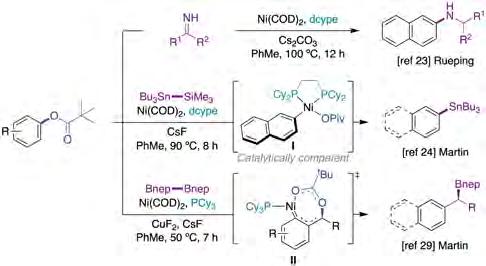
reaction intermediate, thus suggesting a classical catalytic cycle consisting of a transmetallation mediated by fluoride source followed by reductive elimination to forge the targeted C−C bond while releasing the propagating Ni(0)Ln species.
A considerable step-forward in the C−O functionalization arena was the ability to extend these protocols to stereospecific transformations, allowing the transfer of the inherent chirality of the substrates into the targeted products without the need to use particularly expensive chiral ligands [12f ]. The first stereospecific C−C bond-forming reaction using nickel catalysis and benzyl pivalates was independently described by both Jarvo [27] and Watson [28] in 2013. However, it was not until 2017 when Martin and co-workers reported a Ni-catalyzed stereospecific C−heteroatom bond-forming protocol for generating organoboronic esters from the corresponding benzyl pivalates (figure 3, bottom) [29]. Although the reaction was limited to π-extended systems and ortho substituents could not be accommodated, the reaction was equally effective regardless of whether electron-rich or electron-poor arenes were utilized. Unlike other stereospecific protocols, the reaction proceeded with retention of configuration, an observation that suggests the intervention of an SN2’-type oxidative addition that generates a putative π-benzyl nickel(II) intermediate II (figure 3, bottom).
As described in this section, there is ample consensus that C(sp2)−O bond activation might occur via oxidative addition of the C−O linkage to Ni(0)Ln. However, experimental evidence for such a seemingly innocent pathway with monodentate phosphine ligands was altogether absent in the literature. In 2018, Gómez-Bengoa, Burés and Martin reported a combined experimental and computational study on the C−O silylation of aryl esters, where the role of an unorthodox dinickel oxidative addition complexes III (figure 4) in C−O cleavage was demonstrated for the first time [30]. Aiming at highlighting the importance of the dimetallic species in the C−O cleavage of aryl esters, the authors studied in detail the Ni/Cu-catalyzed silylation previously reported by the same group (figure 4, top) [25]. Spectroscopic data, stochiometric experiments and kinetic studies provided a detailed picture of dinickel complexes as off-cycle reservoirs of the active mononickel oxidative addition complex via disproportionation.
Following up on their interest in shedding light on C−O bond-cleavage at the molecular level, early this year Martin and co-workers reported a detailed investigation on how Ni catalysts enable sp2−sp2 bond-formation between aryl esters and arylzinc species (figure 5) [16, 31]. The authors started by demonstrating the long-presumed on-cycle oxidative addition of non-π-extended aryl ester to Ni(0) complexes bearing monodentate phosphines. These species can undergo decomposition forming off-cycle Ni(I) species via disproportionation pathways or via direct comproportionation (figure 5, bottom). Of special interest was the unraveling of the influence of the Zn(II) salts on the catalytic turnover, since they are frequently employed as additives in Ni-catalyzed cross-coupling reactions. In this regard, the authors gathered evidence that Zn salts facilitate decomposition by enabling non-desirable redox processes and ligand sequestering events. On the other hand, transmetallation of well-defined Ni(II) complexes was confirmed to be facilitated by [(PCy3)Zn(Cl)(Ph)]2. Finally, the
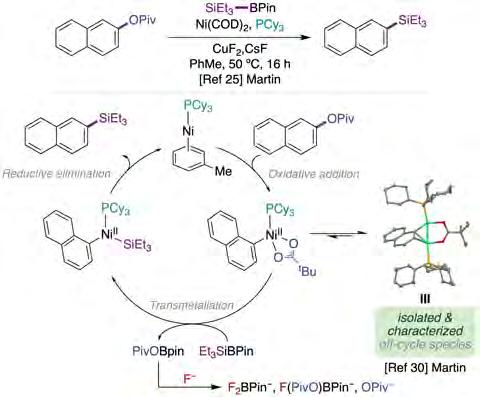
Figure 4. Mechanistic studies on the C−O silylation of aryl esters. Source: Prepared by the authors.
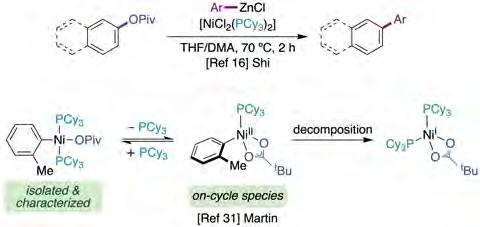
influence of the amide solvents was evaluated, concluding that the formation of (DMA)ZnCl2 or (PCy3)Ni(DMA) adducts prevents decomposition. Interestingly, pyridine provides a similar behavior by restoring the catalytic activity when performing the catalysis in THF.
Reductive cross-coupling reactions
Prompted by a disclosure described independently by Martin, Chatani and Tobisu [32, 33], Han and co-workers reported a Ni-catalyzed reduction of aryl pivalates by using sodium formate as reductant (figure 6) [34]. Interestingly, the catalyst loading can be lowered down to 0.5 mol% without a noticeable decrease in yield. Moreover, functional groups that were not tolerated in previous methods (e.g., carbonyls, nitriles, sulfides, fluorides or carbonyl groups) could all now be well accommodated [32, 33, 35]. As shown previously by Martin [24], the authors demonstrated that the aryl-Ni(II) oxidative addition complex I (figure 6, bottom) was competent as a reaction intermediate. In addition, isotopelabelling experiments confirmed sodium formate as a hydrogen source. Although no further mechanistic studies were performed to determine if the reaction proceeds through a Ni(0)/Ni(I) [36] or Ni(0)/Ni(II) couple, the authors favored a pathway consisting of an oxidative addition, ligand exchange with sodium formate, subsequent decarboxylation to form the nickel-hydride species, and a final reductive elimination. Aryl methyl ethers
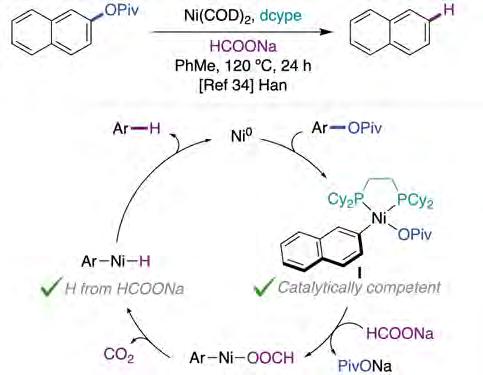
C−C bond-forming reactions
While notable developments of Kumada-Tamao-Corriu reactions using ethereal substrates with both N-heterocyclic carbenes (NHCs) and trialkylphosphine ligands have already been described in the literature [37], the utilization of carbodicarbenes (CDCs) has facilitated unique transformations previously inaccessible with related NHCs ligands [38]. Specifically, Ong and co-workers reported the utility of CDC ligands in Ni-catalyzed Kumada-Corriu reactions under exceptionally mild reaction conditions (figure 7, top) [39]. A variety of aromatic substrates featuring a broad range of electron-neutral, donating or withdrawing groups could be accommodated with equal ease. Competition experiments between naphthalene and anisole derivatives showed high selectivity for the former, indicating that π-extended backbones play a nonnegligible role in reactivity. This observation is certainly not surprising given the superior reactivity of π-extended systems over regular arenes in related C−O bond-functionalization reactions [36a, 37a, 40]. Although the authors propose a transition state that shows the critical role exerted by the Lewis acidity of Mg(II) cations (IV) (figure 8, top), the intermediacy of Ph-Ni(II)-OMe species V is in sharp contrast to the reports by Uchiyama [41] and Martin [36] that suggested that the latter undergoes competitive rapid b-hydride elimination at room temperature (figure 8, bottom).
Driven by the low chemoselectivity profile of Grignard reagents, a considerable effort has been devoted to find alternate organometallic coupling partners for forging C−C bonds in the C−O bond-functionalization arena with improved gen-
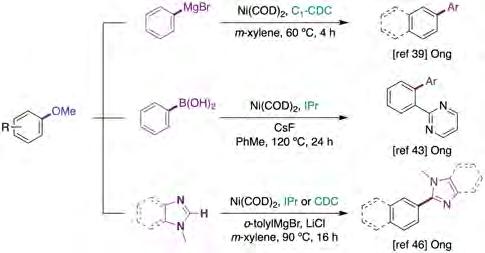
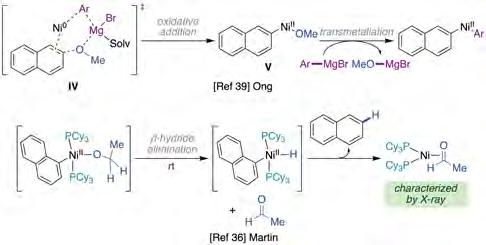
Figure 8. Mechanistic proposal of the reactivity of Ph-Ni(II)-OMe species. Source: Prepared by the authors.
erality, modularity and chemoselectivity profile. To this end, Tobisu and Chatani reported an elegant nickel-catalyzed Suzuki-Miyaura coupling of aryl methyl ethers with sterically bulky organoboron reagents (B2nep2) [42]. As for a myriad of C−OMe bond-functionalization reactions, however, the method was primarily restricted to π-extended aromatics. Subsequently, Ong and co-workers reported a directing group strategy to facilitate the activation of more challenging C−O linkages with regular arene derivatives by using both NHC and CDC ligands (figure 7, middle) [43]. In analogy with Chatani and Tobisu’s work [42, 44], the authors propose that the energy barrier for C−OMe cleavage can be lowered by interaction of CsF and the corresponding aryl boronic esters with the in situ generated Ni(II) intermediates.
While the means to enable cross-coupling reactions of aryl methyl ethers with well-defined organometallic reagents provided a considerable push in chemical innovation, the use of the latter constituted an inherent limitation to the exploration of the full potential of these technologies in the scientific community. Prompted by this observation, chemists were challenged to merge the activation of C−OMe bonds with the ability to trigger C−H functionalization. Although considerable progress was made with related aryl pivalates [45] and aryl carbamates [13g] as C−O electrophiles, it was not until 2018 when Ong reported the first strategy using aryl methyl ethers as coupling partners (figure 7, bottom) [46]. The protocol demonstrates the viability of conducting a cross-coupling reaction of aryl methyl ethers and heteroarene derivatives based on a tandem strategy using Ni(COD)2/IPr and otolylMgBr. Although the incorporation of the latter lowered the functional group tolerance, the scope included π-extended backbones as well as regular anisole derivatives. Preliminary mechanistic studies suggested that Grignard reagents assisted the C−O bond activation via the Lewis acidity of Mg(II) whereas sterically-demanding RMgBr reagents were critical to avoid Kumada-Corriu type side-reactions. In this case, the authors did not require the use of Cs2CO3 as an additive to aid in the formation of the Ni−C bond through the formation of a Cs+ cluster, as proposed by Itami, Musaev and co-workers [45b].
C−heteroatom formation
Despite the significant progress in the C−OMe functionalization arena when forging C−C bonds [37,39-46], it is somewhat intriguing that C−heteroatom bond-forming reactions have found comparatively little echo. The first efforts towards this goal involved elegant studies describing the ability to enable borylation [47] or amination [48] protocols via C−OMe bond-cleavage. It is worth noting, however, that these techniques require particularly electron-rich, yet expensive, phosphine or NHC ligands at considerable high temperatures. Driven by these precedents, Martin and co-workers described a ligand-free C−Si bond formation via Ni-catalyzed C(sp2)−OMe cleavage that operated at room temperature with silylborane reagents (figure 9, top) [49]. In contrast to prior reports, this protocol could be extended to non-π-extended systems or arenes lacking activating groups in the vicinity. In addition, the coupling of benzyl methyl ethers posed no problems. Interestingly, mono or bis-silylation could be enabled by carefully adjusting the stoichiometry of the reaction. The authors propose that the reaction proceeds via ate complex VI (figure 9, top) where the non-coordinating escorting potassium counterion facilitates binding of the OMe motif, thus facilitating a formal nucleophilic aromatic substitution at the C−OMe linkage [50].
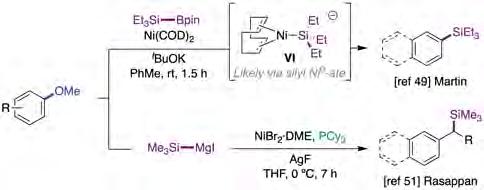
Early this year, Rasappan extended the methodology by promoting a silylation of benzylic C(sp3)−OMe bonds using Me3SiMgI instead of the above-mentioned silylborane (figure 9, bottom) [51]. Interestingly, while Ni(COD)2 completely shut down the reactivity, NiBr2·glyme and NiBr2·diglyme provided the best results when using AgF in THF at 0 °C. Moreover, the strategy could be extended to an enantiospecific silylation with inversion of stereochemistry using enantiopure benzyl alcohol derivatives. Likewise, benzylic C(sp3)−OMe bonds were significantly more reactive than their corresponding C(sp2)−OMe motifs, an observation already made by Martin in 2010 on enabling a formal hydrogenolysis reaction [32]. Unfortunately, however, no in-depth mechanistic studies were performed to unravel the role that AgF might play in the reaction outcome.
Reductive cross-coupling reactions
As previously mentioned, the catalytic reductive cleavage of C−O bonds in phenol derivatives has received significant attention in recent years. In this regard, Martin [32], Chatani [33] and Hartwig [35] made important advances towards this end. However, π-extended systems were considerably more reactive than their simple arene congeners, thus constituting a limitation for further developments. In 2018, Chatani and Tobisu extended the methodology to simple anisole derivatives using diisopropylamino boranes as reducing agents (figure 10) [52], showing that such a system outperformed previously developed protocols aimed to achieve the same goal. Although high temperatures were still required to activate anisole derivatives, biphenyl compounds could be reductively cleaved under milder conditions (180 vs. 100 °C). The authors noticed, however, that an excess of the boron source was needed for the reaction to occur, as parasitic borylation of the solvent was observed in the crude reaction mixtures. Several experiments to unravel the origin of the hydride source were performed by the authors: (1) the use of the isotopically-labelled ArOCD3 VII resulted in no deuterium incorporation into the arene, tacitly suggesting that a pathway consisting of b-hydride elimination from in situ generated Ar-Ni(II)OCD3 was not coming into play (figure 10, bottom); (2) intriguingly, significant deuterium incorporation into all arene C−H bonds was found when utilizing either labelled aminoborane, toluene-d8 or dioxane-d8. Putting all the pieces together, it was not evident how the reaction operates at the molecular level; however, there is little doubt that this contribution might offer new avenues in the years to come, from both the methodological and mechanistic standpoints.
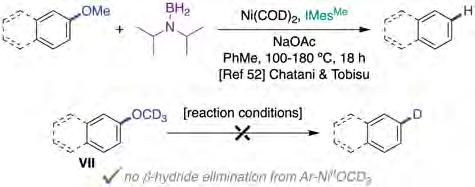
Carboxylic acid derivatives − aryl methyl esters
Non-decarbonylative reactions
C−heteroatom bond-forming reactions
In 2016, Garg and co-workers [53] reported the first example of the utilization of aryl methyl esters (ArCO2Me) as C−O electrophiles, culminating in the development of a catalytic amidation with aniline derivatives based on a Ni(COD)2/SIPr regime (figure 11, top). Although π-extended systems were considerably more reactive than their regular arene congeners, it is worth noting that the reaction could take place at considerably lower temperatures than those observed previously in related C−O functionalization reactions. This can be explained by the use of stoichiometric Al(OtBu)3 as a media-
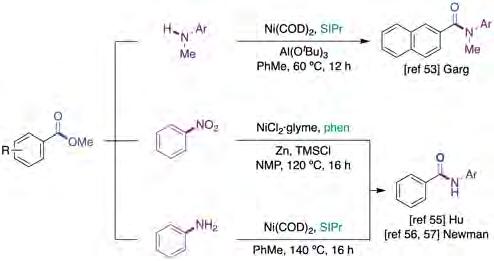
tor, which affects both the kinetics and the thermodynamics of the reaction [54]. Computational studies supported a mechanistic pathway consisting of an oxidative addition, ligand exchange and reductive elimination (figure 12, left). Moreover, decarbonylation was found to be less favored from the corresponding acyl-Ni(II) intermediates.
Subsequently, Hu and co-workers [55] reported an alternative protocol for the conversion of ArCO2Me into anilides employing nitroarenes as coupling partners (figure 11, middle). The use of nitroarenes is not only more step-economical than anilines but also improves the functional group compatibility in the presence of alkyl halides or carbonyl groups that could be susceptible to activation under optimized reaction conditions. Primary alkyl esters showed greater reactivity than the corresponding secondary alkyl analogues, an observation that is consistent with steric considerations. The authors proposed a mechanistic picture that differs from that proposed by Garg [53], where an azobenzene is generated in situ by the presence of a strongly reductive medium. These species presumably react with Ni(0) to form a Ni(II) nitrene intermediate, which reacts via a yet unknown pathway en route to a Ni(II) amidate complex, which is then reduced by Zn to give a zinc amidate and regenerate the Ni(0) catalyst (figure 12, right). One year later, Newman reported a complementary protocol for the catalytic amidation of aryl methyl esters [56] that operates in the absence of stochiometric activating agents, allowing the coupling of a wide range of nucleophilic coupling partners and heterocycle motifs, even in the presence of particularly sensitive functional groups (figure 11, bottom). Subsequently, the authors reported a related contribution that made use of commercially available and air-stable IPr·HCl as the ligand. Even so, the reaction required the utilization of air-sensitive Ni(COD)2 and high reaction temperatures [57].
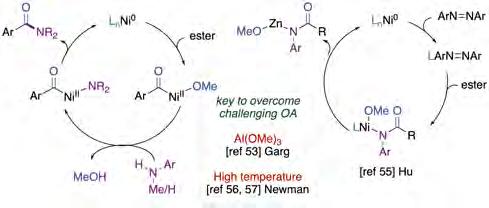
Figure 12. Mechanistic proposals of non-decarbonylative Ni-catalyzed C−heteroatom bond-forming cross-coupling reactions of aryl methyl esters. Source: Prepared by the authors.
C−C bond-forming reactions
In 2019, Newman described the development of a Ni-catalyzed domino Heck-type reaction with aryl methyl esters (figure 13, top and middle) [58]. Inspired by the work of Garg [59] and Stanley [60], the authors proposed that in situ generated acyl-Ni(II) intermediate VIII (figure 14, left) could be trapped intramolecularly by a tethered allyl fragment and sequential intermolecular transmetallation with an organoboron nucleophile or by a b-hydride elimination pathway. Specifically, it was found that the Ni-catalyzed Heck/Suzuki-Miyaura coupling could be enabled by Ni(COD)2/SIPr and a mixture of CsF/KF in THF at 80 °C, whereas the Mizoroki-Heck reaction was achieved by Ni(COD)2/ SIPr·HCl with tBuOK and K3PO4 in toluene at 100 °C for 16 h, and by using 1-phenylethanol as hydride source. The authors support a pathway consisting of an oxidative addition to the C(acyl)−O bond to form a Ni(II) intermediate followed by migratory insertion of the tethered olefin, ultimately triggering a transmetallation and/or reductive elimination to deliver the targeted products.
Early this year, Newman described the development of a Ni-catalyzed Suzuki-Miyaura cross-coupling of aryl methyl esters en route to phenyl ketone derivatives (figure 13, bottom) [61]. Intriguingly, an unusual NHC ligand with remote steric bulk was required for the reaction to occur. As expected, the steric bulk at the ester backbone had a non-negligible impact on reactivity. In any case, the transformation was characterized by its generality across a wide range of substrates bearing different electronic and steric environments. Interestingly, aryl boronic acids could not be employed as substrates whereas a considerable drop in yield was observed by subtle
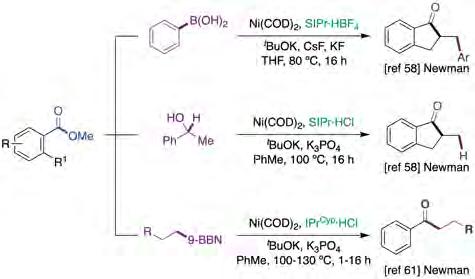
modification of the boronic acid, specifically the absence of aromatic rings within its structure. This observation was supported by theoretical calculations, suggesting the involvement of non-covalent interactions between the catalyst and substrate (figure 14, right). Importantly, the authors showed that the technology could be used in the presence of groups that are a priori amenable to activation with Ni catalysts, suggesting that orthogonal protocols might come into play with a judicious choice of the reaction conditions. Moreover, siteselectivity could be accomplished for substrates possessing electronically-differentiated esters, with particularly electron-poor substrates showing superior reactivity.

Figure 14. Key intermediates in non-decarbonylative Ni-catalyzed C−C bond-forming cross-coupling reactions of aryl methyl esters. Source: Prepared by the authors.
Decarbonylative reactions
C−heteroatom bond-forming reactions
Prompted by a catalytic stannylation reported by Martin when using aryl pivalates as C−O electrophiles and Me3SiSnBu3 [24], Rueping described an otherwise analogue reaction with the same silylstannyl reagent by using aryl methyl esters instead, resulting in a decarbonylative stannylation that operated at high temperatures (figure 15, top) [62]. Interestingly, a subtle change in both the Ni catalyst and the base employed allowed for the coupling of aryl esters with different steric environments. Unfortunately, the authors did not include a mechanistic proposal that explained the results observed.
C−C bond-forming reactions
In 2018, Yamaguchi described the development of a Nicatalyzed methylation of aromatic esters by using dimethylaluminium chloride as both nucleophilic partner and Lewis acid to activate the targeted C−O bond (figure 15, middle) [63]. Not only phenyl- but also alkyl-substituted aryl esters could be used as coupling partners, albeit the technology relied primarily on the utilization of π-extended systems. As for Rueping’s protocol [62], high temperatures (170 °C) and bidentate ligands (dcypt or dppp) were required for the reaction to occur; indeed, the utilization of monodentate PCy3 and NHC ligands significatively decreased the yield of the reaction. While the activation of methyl esters required the presence of aluminium reagents, this was not the case when employing phenyl esters. Unfortunately, the authors did not include a mechanistic proposal of this rather appealing transformation, but one might tentatively anticipate that both transformations occur via a “classical” Ni(0)/Ni(II) mechanistic scenario consisting of oxidative addition, CO extrusion, transmetallation and reductive elimination.
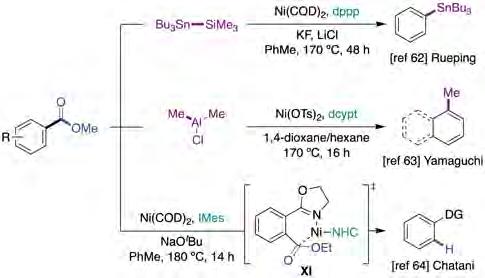
Figure 15. Decarbonylative Ni-catalyzed cross-coupling reactions of aryl methyl esters. Source: Prepared by the authors.
Reductive cross-coupling reactions
In 2019, Chatani reported the nickel-catalyzed reductive defunctionalization of esters in the absence of an external reductant using the Ni(COD)2/IMes couple in toluene at 180 °C (figure 15, bottom) [64]. While excellent yields were obtained for esters bearing OMe, OEt, OBu or OiPr groups, lower results were consistently obtained for sterically encumbered tBu analogues. As for other cross-coupling reactions of C−O electrophiles, the present ortho N-heteroaromatic rings or carbonyl groups could be employed as directing groups to facilitate oxidative addition into the C−O bond (see IX, figure 15), thus setting the stage for triggering a decarbonylation, b-hydride elimination and reductive elimination. Preliminary mechanistic studies suggested an irreversible C−O cleavage and/or decarbonylation, whereas reversibility was proposed for the b-hydride elimination step.
Conclusions
Despite the seminal work reported by Wenkert in 1979 on the nickel-catalyzed cross-coupling of aryl and vinyl ethers with Grignard reagents, the cross-coupling arena had largely been focused on the use of organic halides as electrophilic counterparts. However, in recent years chemists have shown that simple and readily available phenol and aryl carboxylic acid derivatives can be used for similar purposes, representing a worthwhile endeavor for chemical invention. Unfortunately, however, these reactions are still in their infancy compared with the impressive preparative profile of cross-coupling reactions with organic halides. In addition, it is worth noting that little knowledge has been gathered regarding the mechanism by which these reactions operate. Isolated mechanistic studies have revealed that the functionalization of C–O bonds might follow a different rationale from that shown for organic halides, populating pathways a priori beyond reach in the latter while offering new dogmas at molecular level for designing future endeavors. It is consequently reasonable to predict a bright future for the coming years in the C–O functionalization arena, not only by expanding the range of cross-coupling partners that can be utilized in these processes, but also by understanding the mechanistic intricacies of these rather appealing transformations.
Acknowledgments
We thank ICIQ, FEDER/MICIU (AEI/PGC2018-096839-B100) and MCI/AIE (Severo Ochoa Excellence Accreditation 20202023, CEX2019-000925-S) for financial support. C. O. thanks AEI for a predoctoral fellowship (PRE2019-089145).
References
[1] (a) corriu, R. J. P.; masse, J. P. “Activation of Grignard reagents by transition-metal complexes. A new and simple synthesis of trans-stilbenes and polyphenyls”. J. Chem. Soc., Chem. Commun., 0 (1972), 144. (b) tamao, K.; sumitani, K.; kumada, M. “Selective carbon−carbon bond formation by cross-coupling of Grignard reagents with organic halides. Catalysis by nickel-phosphine complexes”. J. Am. Chem. Soc., 94 (1972), 4374-4376. [2] (a) miyaura, N. Cross-coupling reactions: A practical guide. Berlin: Springer-Verlag, 2002. (b) de meJeire, A.; diedricH, F. Metal-catalyzed cross-coupling reactions, 2nd ed. Germany: Wiley-VCH, 2004. (c) camPeau, L. C.; HaZari, N. “Cross-coupling and related reactions: Connecting past success to the development of new reactions for the future”. Organometallics, 38 (2019), 3-35. [3] Wenkert, E.; micHelotti E. L.; sWindell, S. C. “Nickel-induced conversion of carbon−oxygen into carbon−carbon bonds. One-step transformations of enol ethers into olefins and aryl ethers into biaryls”. J. Am. Chem. Soc., 101 (1979), 2246-2247. [4] (a) miyaura, N.; suZuki, A. “Stereoselective synthesis of arylated (E )-alkenes by the reaction of alk-1-enylboranes with aryl halides in the presence of palladium catalyst”. J. Chem. Soc. Chem. Commun. (1979), 866-867. (b) miyaura, N.; yamada, K.; suZuki, A. “A new stereospecific cross-coupling by the palladium-catalyzed reaction of 1-alkenylboranes with 1-alkenyl or 1-alkynyl halides”. Tetrahedron Lett., 36 (1979), 3437-3440. [5] (a) luo, Y.-R. Handbook of bond dissociation energies in organic compound. FL: CRC Press, 2007. (b) alPer, S. M. H.; gossage, R. A.; grusHin, V. V.; Hidai, M.; ito, Y.; Jones, W. D.; kakiucHi, F.; van koten, G.; lin, Y.-S.; miZomBe, Y.; murai, S.; murakami, M.; ricHmond, T. G.; sen, A.; suginome, M.; yamamoto, A. Activation of unreactive bond and organic synthesis. Berlin: Springer, 1999. [6] senguPta, S.; leite, M.; raslan, D. S.; quesnelle, C.; snieckus, V. “Ni(0)-catalyzed cross-coupling of aryl O-carbamates and aryl triflates with Grignard reagents. Directed ortho metalationaligned synthetic methods for polysubstituted aromatics via a 1,2-dipole equivalent”. J. Org. Chem., 57 (1992), 4066-4068. [7] dankWardt, J. W. “Nickel-catalyzed cross-coupling of aryl Grignard reagents with aromatic alkyl ethers: An efficient synthesis of unsymmetrical biaryls”. Angew. Chem. Int. Ed., 43 (2004), 2428-2432. [8] quasdorF, K. W.; tian, X.; garg, N. K. “Cross-coupling reactions of aryl pivalates with boronic acids”. J. Am. Chem. Soc., 130 (2008), 14422-14423. [9] guan, B.-T.; Wang, Y.; li, B.-J.; yu, D.-G.; sHi, Z.-J. “Biaryl construction via Ni-catalyzed C−O activation of phenolic carboxylates”. J. Am. Chem. Soc., 130 (2008), 14468-14470. [10] Most recent examples: (a) yue, H.; guo, L.; liao, H.-H.; cai, Y.; ZHu, C.; ruePing, M. “Catalytic ester and amide to amine interconversion: Nickel-catalyzed decarbonylative amination of esters and amides by C−O and C−C bond activation”. Angew. Chem. Int. Ed., 56 (2017), 4282-4285. (b) yue, H.; guo, L.; lee,
S.-C.; liu, X.; ruePing, M. “Selective reductive removal of ester and amide groups from arenes and heteroarenes through nickel-catalyzed C−O and C−N bond activation”. Angew. Chem. Int. Ed., 56 (2017), 3972-3976. (c) liu, X.; Jia, J.; ruePing, M. “Nickel-catalyzed C−O bond-cleaving alkylation of esters: Direct replacement of the ester moiety by functionalized alkyl chains”. ACS Catal., 7 (2017), 4491-4496. (d) cHatuPHeeraPHat, A.; liao, H.-H.; simontree, W.; guo, L.; minenkov, Y.; Poater, A.; cavallo, L.; ruePing, M. “Ligand-controlled chemoselective C(acyl)−O bond vs C(aryl)−C bond activation of aromatic esters in nickel catalyzed C(sp2)−C(sp3) cross-couplings”. J. Am. Chem. Soc., 140 (2018), 3724-3735. (e) yang, F.; ding, D.; Wang, C. “Nickel-catalyzed direct cross-electrophile coupling of phenolic esters with alkyl bromides”. Org. Lett., 22 (2020), 9203-9209. (f) malaPit, C. A.; Borrell, M.; milBauer, M. W.; BrigHam, C. E.; sanFord, M. S. “Nickel-catalyzed decarbonylative amination of carboxylic acid esters”. J. Am. Chem. Soc., 142 (2020), 5918-5923. [11] guo, L.; ruePing, M. “Decarbonylative cross-couplings: Nickel catalyzed functional group interconversion strategies for the construction of complex organic molecules”. Acc. Chem. Res., 51 (2018), 1185-1195. [12] Selected reviews on C–O bond cleavage: (a) rosen, B. M.; quasdorF, K. W.; Wilson, D. A.; ZHang, N.; resmerita, A.-M.; garg, N. K.; Percec, V. “Nickel-catalyzed cross-couplings involving carbon−oxygen bonds”. Chem. Rev., 111 (2011), 1346-1416. (b) yamagucHi, J.; muto, K.; itami, K. “Recent progress in nickel catalyzed biaryl coupling”. Eur. J. Org. Chem., (2013), 19-30. (c) mesganaW, T.; garg, N. K. “Ni- and Fe catalyzed crosscoupling reactions of phenol derivatives”. Org. Process Res. Dev., 17 (2013), 29-39. (d) cornellÀ, J.; Zárate, C.; martin, R. “Metal-catalyzed activation of ethers via C−O bond cleavage: A new strategy for molecular diversity”. Chem. Soc. Rev., 43 (2014), 8081-8097. (e) su, B.; cao, Z.-C.; sHi, Z.-J. “Exploration of earth-abundant transition metals (Fe, Co, and Ni) as catalysts in unreactive chemical bond activations”. Acc. Chem. Res., 48 (2015), 886-896. (f) tolleFson, E. J.; Hanna, L. E.; Jarvo, E. R. “Stereospecific nickel-catalyzed cross-coupling reactions of benzylic ethers and esters”. Acc. Chem. Res., 48 (2015), 2344-2353. (g) toBisu, M.; cHatani, N. “Nickel-catalyzed cross-coupling reactions of unreactive phenolic electrophiles via C−O bond activation”. Top. Curr. Chem., 374 (2016), 1-28. (h) Zeng, H.; qiu, Z.; domíngueZ-Huerta, A.; Hearne, Z.; cHen, Z.; li, C.-J. “An adventure in sustainable cross-coupling of phenols and derivatives via carbon−oxygen bond cleavage”. ACS Catal., 7 (2017), 510-519. (i) lin, G.; ruePing, M. “Decarbonylative cross-couplings: Nickel catalyzed functional group interconversion strategies for the construction of complex organic molecules”. Acc. Chem. Res., 51 (2018), 1185-1195. (j) toBisu, M. Nickel catalysis in organic synthesis: Methods and reactions. C−O Bond Transformations. Germany: Wiley, 2020. [13] Most recent examples: (a) quasdorF, K. W.; riener, M.; Petrova, K. V.; garg, N. K. “Suzuki-Miyaura coupling of aryl carbamates, carbonates, and sulfamates”. J. Am. Chem. Soc., 131 (2009), 17748-17749. (b) antoFt-FincH, A.; BlackBurn, T.; snieckus, V. “N,N-diethyl O-carbamate: Directed metalation group and orthogonal Suzuki-Miyaura cross-coupling partner”. J. Am. Chem. Soc., 131 (2009), 17750-17752. (c) Huang, K.; yu, D.-G.; ZHeng, S.-F.; Wu, Z.-H.; sHi, Z.-J. “Borylation of aryl and alkenyl carbamates through Ni-catalyzed C−O activation”. Chem. Eur. J., 17 (2011), 786-791. (d) mesganaW, T.; silBerstein, A. L.; ramgren, S. D.; natHel, N. F. F.; Hong, X.; liu, P.; garg, N. K. “Nickel-catalyzed amination of aryl carbamates and sequential site-selective cross-couplings”. Chem. Sci., 2 (2011), 1766-1771. (e) takise, R.; itami, K.; yamagucHi, J. “Cyanation of phenol derivatives with aminoacetonitriles by nickel catalysis”. Org. Lett., 18 (2016), 4428-4431. (f) sHi, W.-J.; ZHao, H.-W.; Wang, Y.; cao, Z.-C.; ZHang, L.-S.; yu, D.-G.; sHi, Z.-J. “Nickel- or iron-catalyzed cross-coupling of aryl carbamates with arylsilanes”. Adv. Synth. Catal., 358 (2016), 24102416. (g) Wang, Y.; Wu, S.-B.; sHi, W.-J.; sHi, Z.-J. “C−O/C−H coupling of polyfluoroarenes with aryl carbamates by cooperative Ni/Cu catalysis”. Org. Lett., 18 (2016), 2548-2551. [14] ogaWa, H.; yang, Z.-K.; minami, H.; koJima, K.; saito, T.; Wang, C.; ucHiyama, M. “Revisitation of organoaluminium reagents affords a versatile protocol for C−X (X = N, O, F) bond-cleavage cross-coupling: A systematic study”. ACS Catal., 7 (2017), 3988-3994. [15] murugesan, V.; BalakrisHnan, V.; rasaPPan, R. “Nickelcatalyzed cross-coupling reaction of carbamates with silylmagnesium reagents”. Journal of Catalysis, 377 (2019), 293-298. [16] li, B.-J.; li. Y.-Z.; lu, X.-Y.; liu, J.; sHi, Z.-J. “Cross-coupling of aryl/alkenyl pivalates with organozinc reagents through nickel-catalyzed C−O bond activation under mild reaction conditions”. Angew. Chem. Int. Ed., 47 (2008), 10124-10127. [17] nisHimura, T.; uemura, S. “Palladium-catalyzed arylation of tert-cyclobutanols with aryl bromide via C−C bond cleavage: New approach for the g-arylated ketones”. J. Am. Chem. Soc. 121 (1999), 11010-11011. [18] Ziadi, A.; martin, R. “Ligand-accelerated Pd-catalyzed ketone g-arylation via C−C cleavage with aryl chlorides” Org. Lett., 14 (2012), 1266-1269.
[19] gan, Y.; ZHang, N.; Huang, S.; liu, Y. “Nickel-catalyzed cross-coupling of aryl pivalates with cyclobutanols involving C−O and C−C bond cleavage”. Chin. J. Chem., 38 (2020), 1686-1690. [20] clevenger, A. L.; stolley, R. M.; aderiBigBe, J.; louie, J. “Trends in the usage of bidentate phosphines as ligands in nickel catalysis”. Chem. Rev., 120 (2020), 6124-6196. [21] muto, K.; yamagucHi, J.; itami, K. “Nickel-catalyzed C−H/C−O coupling of azoles with phenol derivatives”. J. Am. Chem. Soc., 134 (2012), 169-172. [22] sHimasaki, T.; toBisu, M.; cHatani, N. “Nickel-catalyzed amination of aryl pivalates by the cleavage of aryl C−O bonds”. Angew. Chem. Int. Ed., 49 (2010), 2929-2932. [23] yue, H.; guo, L.; liu, X.; ruePing, M. “Nickel-catalyzed synthesis of primary aryl and heteroaryl amines via C−O bond cleavage”. Org. Lett., 19 (2017), 1788-1791. [24] gu, Y.; martin, R. “Ni-catalyzed stannylation of aryl esters via C−O bond cleavage”. Angew. Chem. Int. Ed., 56 (2017), 3187-3190. [25] Zárate, C.; martin, R. “A mild Ni/Cu-catalyzed silylation via C−O cleavage”. J. Am. Chem. Soc., 136 (2014), 2236-2239. [26] muto, K.; yamagucHi, J.; lei, A.; itami, K. “Isolation, structure, and reactivity of an arylnickel(II) pivalate complex in catalytic C−H/C−O biaryl coupling”. J. Am. Chem. Soc., 135 (2013), 16384-16387. [27] Harris, M. R.; Hanna, L. E.; greene, M. A.; moore, C. E.; Jarvo, E. R. “Retention or inversion in stereospecific nickelcatalyzed cross-coupling of benzylic carbamates with arylboronic esters: Control of absolute stereochemistry with an achiral catalyst”. J. Am. Chem. Soc., 135 (2013), 33033306. [28] ZHou, Q.; srinivas, H. D.; desguPta, S.; Watson, M. P. “Nickel-catalyzed cross-couplings of benzylic pivalates with arylboroxines: Stereospecific formation of diarylalkanes and triarylmethanes”. J. Am. Chem. Soc., 135 (2013), 3307-3310. [29] martín-montero, R.; krolikoWski, T.; Zárate, C.; manZano, R.; martin, R. “Stereospecific nickel-catalyzed borylation of secondary benzyl pivalates”. Synlett, 28 (2017), 2604-2608. [30] somerville, R. J.; Hale, L. V. A.; gómeZ-Bengoa, E.; Burés, J.; martin, R. “Intermediacy of Ni−Ni species in sp2 C−O bond cleavage of aryl esters: Relevance in catalytic C−Si bond formation”. J. Am. Chem. Soc., 140 (2018), 8771-8780. [31] day, C. S.; somerville, R. J.; martin, R. “Deciphering the dichotomy exerted by Zn(II) in the catalytic sp2 C−O bond functionalization of aryl esters at the molecular level”. Nature Catalysis, 4 (2021), 124-133. [32] álvareZ-Bercedo, P.; martin, R. “Ni-catalyzed reduction of inert C−O bonds: A new strategy for using aryl ethers as easily removable directing groups”. J. Am. Chem. Soc., 132 (2010), 17352-17353. [33] toBisu, M.; yamakaWa, K.; cHatani, N. “Nickel-catalyzed reductive cleavage of aryl−oxygen bonds in alkoxy- and pivaloxyarenes using hydrosilanes as a mild reducing agent”. Chem. Commun., 47 (2011), 2946-2948. [34] Xi, X.; cHen, T.; ZHang, J.-S.; Han, L.-B. “Efficient and selective hydrogenation of C−O bonds with a simple sodium formate catalyzed by nickel”. Chem. Commun., 54 (2018), 1521-1524 [35] sergeev, A. G.; HartWig, J. F. “Selective, nickel-catalyzed hydrogenolysis of aryl ethers”. Science, 332 (2011), 439-444. [36] cornellÀ, J.; gómeZ-Bengoa, E.; martin, R. “Combined experimental and theoretical study on the reductive cleavage of inert C−O bonds with silanes: Ruling out a classical Ni(0)/Ni(II) catalytic couple and evidence for Ni(I) intermediates”. J. Am. Chem. Soc., 135 (2013), 1997-2009. [37] Selected examples of Ni-catalyzed KTC coupling reactions of aryl methyl ethers using phosphine or NHC ligands: (a) guan, B.-T.; Xiang, S.-K.; Wu, T.; sun, Z.-P.; Wang, B.-Q.; ZHaoB, K.-Q.; sHi, Z.-J. “Methylation of arenes via Ni-catalyzed aryl C−O/F activation”. Chem. Commun. (2008), 1437-1439. (b) Xie, L.-G.; Wang, Z.-X. “Cross-coupling of aryl/alkenyl silyl ethers with Grignard reagents through nickel-catalyzed C−O activation”. Chem. Eur. J., 17 (2011), 4972-4975. (c) iglesias, M. J.: Prieto, A.; nicasio, M. C.; “Kumada-Tamao-Corriu coupling of heteroaromatic chlorides and aryl ethers catalyzed by (IPr)Ni(allyl)Cl”. Org Lett., 14 (2012), 4318-4321. (d) ZHang, J.; Xu, J.; Xu, Y.; sun, H.; sHen, Q.; ZHang, Y. “Mixed NHC/phosphine Ni(II) complexes: Synthesis and their applications as versatile catalysts for selective cross-couplings of ArMgX with aryl chlorides, fluorides, and methyl ethers”. Organometallics, 34 (2015), 5792-5800. (e) toBisu, M.; takaHira, T.; oHtsuki, A.; cHatani, N. “Nickel-catalyzed alkynylation of anisoles via C−O bond cleavage”. Org. Lett., 17 (2015), 680-683. (f) toBisu, M.; takaHira, T.; morioka, T.; cHatani, N. “Nickel-catalyzed alkylative cross-coupling of anisoles with Grignard reagents via C−O bond activation”. J. Am. Chem. Soc., 138 (2016), 6711-6714. [38] Selected examples: (a) liu, S.-K.; sHiH, W.-C.; cHen, W.-C.; ong, T.-G. “Carbodicarbenes and their captodative behavior in catalysis”. Chem. Cat. Chem., 10 (2018), 1483-1498. (b) cHen, W.-C.; Hsu, Y.-C.; lee, C.-Y.; yaP, G. P. A.; ong, T.-G. “Synthetic modification of acyclic bent allenes (carbodicarbenes) and further studies on their structural implications and reactivities”.
Organometallics, 32 (2013), 2435-2442. (c) cHen, W.-C.; sHiH, W.-C.; Jurca, T.; ZHao, L.; andrada, D. M.; Peng, C.-J.; cHang, C.-C.; liu, S.-K.; Wang, Y.-P.; Wen, Y.-S.; yaP, G. P. A.; Hsu, C.-P.; Frenking, G.; ong, T.-G. “Carbodicarbenes: Unexpected paccepting ability during reactivity with small molecules”. J. Am. Chem. Soc., 139 (2017), 12830-12836. [39] amBre, R.; yang, H.; cHen, W.-C.; yaP, G. P. A.; Jurca, T.; ong, T.-G. “Nickel carbodicarbene catalyzes Kumada crosscoupling of aryl ethers with Grignard reagents through C−O bond activation”. Eur. J. Inorg. Chem., 30 (2019), 3511-3517. [40] Wang, C.; oZaki, T.; takita, R.; ucHiyama, M. “Aryl ether as a Negishi coupling partner: An approach for constructing C−C bonds under mild conditions”. Chem. Eur. J., 18 (2012), 34823485. [41] ogaWa, H.; minami, H.; oZaki, T.; komagaWa, S.; Wang, C.; ucHiyama, M. “How and why does Ni0 promote smooth etheric C−O bond cleavage and C−C bond formation? A theoretical study”. Chem. Eur. J., 21 (2015), 13904-13908. [42] toBisu, M.; sHimasaki, T.; cHatani, N. “Nickel-catalyzed cross-coupling of aryl methyl ethers with aryl boronic esters”. Angew. Chem. Int. Ed., 47 (2008), 4866-4869. [43] amBre, R.; Wang, T.-H.; Xian, A.; cHen, Y.-S.; liang, Y.-F.; Jurca, T.; ZHao, L.; ong, T.-G. “Directing group-promoted inert C−O bond activation using versatile boronic acid as a coupling agent”. Chem. Eur. J., 26 (2020), 17021-17026. [44] scHWarZer, M. C.; konno, R.; HoJo, T.; oHtsuki, A.; nakamura, K.; yasutome, A.; takaHasHi, H.; sHimasaki, T.; toBisu, M.; cHatani, N.; Mori, S. “Combined theoretical and experimental studies of nickel-catalyzed cross-coupling of methoxyarenes with arylboronic esters via C−O bond cleavage”. J. Am. Chem. Soc., 139 (2017), 10347-10358. [45] (a) muto, K.; yamagucHi, J.; itami, K. “Nickel-catalyzed C−H/C−O coupling of azoles with phenol derivatives”. J. Am. Chem. Soc., 134 (2012), 169-172. (b) Xu, H.; muto, K.; yamagucHi, J.; ZHao, C.; itami, K.; musaev, D. “Key mechanistic features of Ni-catalyzed C−H/C−O biaryl coupling of azoles and naphthalen-2-yl pivalates”. J. Am. Chem. Soc., 136 (2014), 14834-14844. [46] (a) Wang, T.-H.; amBre, R.; Wang, Q.; lee, W.-C.; Wang, P.C.; liu, Y.; ZHao, L.; ong, T.-G. “Nickel-catalyzed heteroarenes cross coupling via tandem C−H/C−O activation”. ACS Catal., 8 (2018), 11368-11376. (b) Xu, H.; muto, K.; yamagucHi, J.; ZHao, C.; itami, K.; musaev, D. “Key mechanistic features of Nicatalyzed C−H/C−O biaryl coupling of azoles and naphthalen2-yl pivalates”. J. Am. Chem. Soc., 136 (2014), 14834-14844. [47] Zárate, C.; manZano, R.; martin, R. “Ipso-borylation of aryl ethers via Ni-catalyzed C−OMe cleavage”. J. Am. Chem. Soc., 137 (2015), 6754-6757. [48] Selected references: (a) toBisu, M.; yasutome, A.; yamakaWa, K.; sHimasaki, T.; cHatani, N. “Ni(0)/NHC-catalyzed amination of N-heteroaryl methyl ethers through the cleavage of carbon− oxygen bonds”. Tetrahedron, 68 (2012), 5157-5161. (b) toBisu, M.; sHimasaki, T.; cHatani, N. “Ni0-catalyzed direct animation of anisoles involving the cleavage of carbon-oxygen bonds”. Chem. Lett., 38 (2009), 710-711. [49] Zárate, C.; nakaJima, M.; martin, R. “A mild and ligand-free Ni-catalyzed silylation via C−OMe cleavage”. J. Am. Chem. Soc., 139 (2017), 1191-1197. [50] For related ate-complexes, see: (a) Jonas, K.; PörscHke, K. R.; krüger, C.; tsay, Y.-H. “Carbanion complexes of nickel(0)”. Angew. Chem. Int. Ed., 15 (1976), 621-622. (b) iWasaki, T.; miyata, Y.; akimoto, R.; Fujii, Y.; kuniyasu, H.; kamBe, N. “Diarylrhodates as promising active catalysts for the arylation of vinyl ethers with Grignard reagents”. J. Am. Chem. Soc., 136 (2014), 9260-9263.
[51] BalakrisHnan, V.; murugesan, V.; cHindan, B.; rasaPPan, R. “Nickel-mediated enantiospecific silylation via benzylic C−OMe bond cleavage”. Org. Lett., 23 (2021), 1333-1338. [52] igarasHi, T.; Haito, A.; cHatani, N.; toBisu, M. “Nickelcatalyzed reductive cleavage of carbon−oxygen bonds in anisole derivatives using diisopropylaminoborane”. ACS Catal., 8 (2018), 7475-7483. [53] Hie, L.; Fine natHel, N. F.; Hong, X.; yang, Y.-F.; Houk, K. N.; garg, N. K. “Nickel-catalyzed activation of acyl C−O bonds of methyl esters”. Angew. Chem. Int. Ed., 55 (2016), 2810-2814. [54] liu, X.; Hsiao, C.-C.; kalvet, I.; leiendecHer, M.; guo, L.; scHoeneBeck, F.; ruePing, M. “Lewis acid assisted nickelcatalyzed cross-coupling of aryl methyl ethers by C−O bond-cleaving alkylation: Prevention of undesired b-hydride elimination”. Angew. Chem. Int. Ed., 55 (2016), 6093-6098. [55] cHeung, C. W.; Ploeger, M. L.; Hu, X. “Direct amidation of esters with nitroarenes”. Nat. Commun., 8 (2017), 1487814888. [56] Halima, T. B.; masson-makdissi, J.; neWman, S. G. “Nickelcatalyzed amide bond formation from methyl esters”. Angew. Chem. Int. Ed., 57 (2018), 12925-12929. [57] ZHeng, Y.-L.; neWman, S. G. “Methyl esters as crosscoupling electrophiles: Direct synthesis of amide bonds”. ACS Catal., 9 (2019), 4426-4433. [58] ZHeng, Y.-L.; neWman, S. G. “Nickel-catalyzed domino Hecktype reactions using methyl esters as cross-coupling electrophiles”. Angew. Chem. Int. Ed., 58 (2019), 18159-18164.
[59] medina, J. M.; moreno, J.; racine, S.; du, S.; garg, N. K. “Mizoroki-Heck cyclizations of amide derivatives for the introduction of quaternary centers”. Angew. Chem. Int. Ed., 56 (2017), 6567-6571. [60] (a) Walker, Jr. J. A.; vickerman, K. L.; Humke, J. N.; stanley, L. M. “Ni-catalyzed alkene carboacylation via amide C−N bond activation”. J. Am. Chem. Soc., 139 (2017), 10228-10231. (b) kadam, A. A.; metZ, T. L.; qian, Y.; stanley, L. M. “Ni-catalyzed three-component alkene carboacylation initiated by amide C−N bond activation”. ACS Catal., 9 (2019), 5651-5656. [61] ZHeng, Y.-L.; Xie, P.-P.; danesHFar, O.; Houk, K. N.; Hong, X.; neWman, S. G. “Direct synthesis of ketones from methyl esters by nickel-catalyzed Suzuki-Miyaura coupling”. Angew. Chem. Int. Ed., 60 (2021), 2-10. [62] yue, H.; ZHu, C.; ruePing, M. “Catalytic ester to stannane functional group interconversion via decarbonylative cross-coupling of methyl esters”. Org. Lett., 20 (2018), 385-388. [63] okita, T.; muto, K.; yamagucHi, J. “Decarbonylative methylation of aromatic esters by a nickel catalyst”. Org. Lett., 20 (2018), 3132-3135. [64] iyori, Y.; takaHasHi, K.; yamaZaki, K.; ano, Y.; cHatani, N. “Nickel-catalyzed reductive defunctionalization of esters in the absence of an external reductant: Activation of C−O bonds”. Chem. Commun., 55 (2019), 13610-13613.
C. Odena L. Talavera R. Martin
Carlota Odena received her B.Sc. degree in Chemistry (2018) and her M.Sc. degree in Synthesis, Catalysis and Molecular Design (2019) from Universitat Rovira i Virgili (URV) and ICIQ, and wrote both her Bachelor’s degree and Master’s theses under the supervision of Prof. Mónica H. Pérez-Temprano at the Institut Català d’Investigació Química (ICIQ). In October 2019 she began her doctoral studies under the supervision of Prof. Ruben Martin at ICIQ, working on the synthesis of nickel complexes for mechanistic understandings.
Laura Talavera received her B.Sc. degree in Chemistry (2015) from Universitat Autònoma de Barcelona (UAB) and her M.Sc. degrees (2016 and 2017) from UAB and Esteve Química, S.A. She then moved to the United Kingdom to work as a scientist at Aptuit LLC. In October 2019, she joined Prof. Ruben Martin’s group at ICIQ, where her research is focused on the area of C−O bond-activation and catalytic functionalization of olefin feedstocks via functionalization of remote C−sp3 sites.
Ruben Martin conducted his undergraduate studies at the Universitat de Barcelona (UB). He then received his PhD in 2003 from UB under the guidance of Prof. Antoni Riera. In 2004, he moved to the Max-Planck Institut für Kohlenforschung as a Humboldt postdoctoral fellow with Prof. Alois Fürstner. In 2005, he undertook further postdoctoral studies at MIT with Prof. Stephen L. Buchwald as an MEC-Fulbright fellow. In September 2008, he initiated his independent career as an assistant professor at the ICIQ (Tarragona). In July 2013, he was promoted to associate professor and subsequently to ICREA research professor. His research is focused on the development of new metal-catalyzed activation technologies of particularly strong s-bonds.









